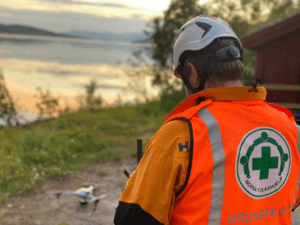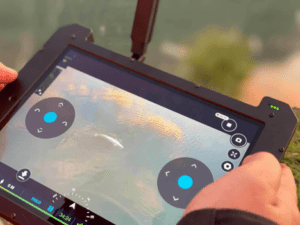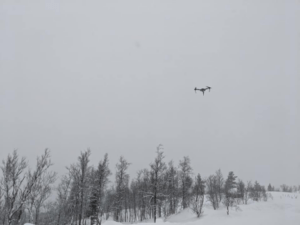
There is nothing better than a search and rescue story – no matter who it is being rescued. Last week, Atlas Dynamics documented the drone rescue of a Beluga whale – an endangered species – by the Norwegian People’s AID Search and Rescue Unit, using the AtlasPRO UAS.
Atlas Dynamics is a global leader in autonomous unmanned aerial systems (UAS), one of the first small automated solutions to be introduced. The AtlasPRO is used all over the world – and for the Norwegian People’s AID (NPAID) Midt-Troms SAR (Search & Rescue) Unit, it’s a critical tool.
The NPAID Mid-Troms unit is a volunteer SAR unit operating in northern Norway specializing in first response and lifesaving operations in extreme Arctic environments. The unit covers a region of Arctic Norway famous for its sparsely populated mountain ranges and many fjords. The NPAID team ensures the safety of tourists in the region, especially as adventure tourism continues to increase.
On Wednesday evening, July 29, the Wildlife Board of the Målselv municipality was notified of a white whale on its way up a river from the sea. This situation constitutes a great threat to the whale, as the river has sandbanks and depth variations that can cause a tide-trap.
When Only a Drone Will Work
A wildlife rescue operation was launched to lead the whale back to deep water – but during that operation, the whale was lost from sight. The local wildlife force then requested the assistance of the Norwegian People’s Aid Midt-Troms to help locate the missing endangered whale, and provide aerial intelligence for the operation. NPAID Midt-Troms is known for missions of locating and rescuing people in extreme Arctic conditions: they were well qualified for this new type of mission. Using their expertise and Atlas’ drone technology, NPAID was able to locate the missing whale and orchestrate the rescue operation, ensuring all the forces had the information needed in order to get the whale back to deeper water.
“We searched from a relatively high altitude of 70m-100m, since the object we were looking for would stand out so markedly,” said Kenneth Brattli Molund, the unit leader and RPAS project SAR technology integration manager from NPAID in Mid-Troms. “Using the AtlasPRO drone, we were able to locate the whale within 10 minutes, create a clear situational overview, and control the rescue operation from above.”
Getting the Whale Back to Sea

In order to attract the whale out towards sea, the local wildlife marine force created a firm sound using empty bottles that was towed to the rear of the boat. The sound Eco-waved the orientation to the whale, and it followed the boat back to sea, to safety. It all happened without physical interference, which is one of the task-force’s main values when addressing wildlife.
As a highly sophisticated and professional SAR force, NPAID Midt-Troms is an early adopter of innovative technologies and its project team is constantly evaluating tools aimed at optimizing SAR operations. The AtlasPRO drone has been certified to work in extreme Arctic conditions: that’s why it was chosen by NPAID Midt-Troms SAR unit for their missions. “We have chosen the AtlasPRO for its ability to withstand and deliver unique sensor setups and operate in harsh conditions, and also due to Atlas’ capabilities as a technology design-house, that allows us to dream bigger and co-design better, faster and safer SAR solutions” Molund says.

“We are extremely proud to see our technology being used by professionals such as NPAID Midt-Troms for impactful missions” said Ivan Tolchinsky, CEO and Founder of Atlas Dynamics. “We are used seeing our products save human life, but are extremely happy that we have the ability to assist these great people with wildlife protection as well.”
“This mission was a special one for us.” Molund adds, “We are very happy that we were able to contribute to both animals and people.” The story has a happy ending: the whale was last observed in another fjord not too far away, safe and sound, due to the great work of the forces on the ground, sea, and air.
Video: the Drone Rescue of a Beluga Whale in the Arctic Sea

Miriam McNabb is the Editor-in-Chief of DRONELIFE and CEO of JobForDrones, a professional drone services marketplace, and a fascinated observer of the emerging drone industry and the regulatory environment for drones. Miriam has penned over 3,000 articles focused on the commercial drone space and is an international speaker and recognized figure in the industry. Miriam has a degree from the University of Chicago and over 20 years of experience in high tech sales and marketing for new technologies.
For drone industry consulting or writing, Email Miriam.
TWITTER:@spaldingbarker
Subscribe to DroneLife here.







[…] Drone Rescue of Beluga Whale in the Arctic Sea […]